“You drink more [rosé] than a heavy red or an acidic white,” Tom says from his doorstep perch inside Château d’Esclans. That’s “one of the delightful qualities” of this type of wine, he says.
It’s the best sort of marketing strategy for a winery: a product that sells itself – and in quantity. It’s almost as good as Arm & Hammer’s idea that you buy a box of baking soda and pour it down the drain.
Philippe and I gather with a dozen others, all of us recipients of a special invitation to the château’s glorious grounds. We crowd onto a small balcony outside the estate’s production facilities where one of its marketing chiefs, an American transplant dressed in a pink button-down shirt and pink ballcap – or should I call the colour by its French equivalent of “rosé”? – chirpily shares the wine’s attributes.
The owner’s overall aim, Tom says, is to make “the world’s greatest and most expensive rosé.”
It’s the sort of line I suspect will appeal to this crowd. The first guests Philippe and I met this late morning were two male pin-ups from Monaco. They, too, had made a decent effort in finding this winery in Côtes de Provence, a region in eastern Provence known for its abundance of rosé production. After a few wrong turns, we all could attest to the fact that Château d’Esclans’ neighbours are more vineyards.
The poster boys had lush hair that sprung with health. Their faces bore tans of the good life. “Who’s driving home?” Philippe asked.
The blonde one raised his hand. After the slightest of pauses, the brunet offered an explanation. He lost his license a couple weeks earlier.
“Too much wine tasting?” Philippe asked.
It was a lot more than tasting, the bloke said, without a flicker of remorse.
Minutes later we were joined by a leggy Argentine who reached a full six-foot-six in her strappy heels and cowboy hat. Her opening gambit was about ghosts. Her sidekick wore a long, strapless, silken dress in dusty rose. A piece of cloth wove poetically through her braided up-do.
Yes, great and expensive rosé – a brand that befits the high life – is precisely what should appeal to this lot. And even though I’m feeling a little grown-up and staid among them, I can verify that the estate’s Whispering Angel brand populates several notable menus along the Côte d’Azur.
Having spent the summer here, only repeating our dozen-year connection with this area, Philippe and I know rosé wine. It’s for lunch and apéros and dinner. It goes down easily at home, in the restaurant and bistro, and on the beach. Put simply, it’s dangerous. Forget croissants and baguettes: Rosé is the prime offender of summertime pounds, launching me into survival mode every June before we even reach this corner of paradise.
Rosé wine is currency. Philippe won a golf tournament recently in Cannes. His prize? A magnum of rosé. The wine’s popularity also extends beyond these borders. Hoxton, an area of East London, recently celebrated the Rosé Festival. This summer Toronto hosted its inaugural Rosé Picnic. (Perhaps these two cities, not generally noted for their sunshine, thought they’d appear more summery through rosé-tinted glasses?)
“Millennials are just snapping it up,” Tom tells our group from his doorstep perch as we shade ourselves from Provence’s scorching sunshine. “Social media is playing this tremendous role.”
So that’s what my 12-year old is watching all the time. (Okay, let’s really hope not.)

The current owner of Château d’Esclans, a Frenchman from Bordeaux, bought the estate 11 years ago from a Swedish pension fund that had eked only a small amount of wine out of the land. The new team started with an annual production of 136,000 bottles and has gradually built up the infrastructure. Production for 2016, which continues to go into its vessels, is slated at 6.4 million bottles.
The owner changed the brand’s name, Tom explains, “to reinvigorate the château’s personality.” It’s clearly working. Seventy percent of production is destined for the US, with the UK running second and France a stagnant third. Other spots hot on the brand are “places that lend themselves to the rosé lifestyle,” he says. Names like Ibiza, Mykonos, and St Barths pepper his presentation.
Up to this point, our host has shown us how the grapes are sorted, cooled, pressed and aged. We’ve even spotted two barrels of the château’s kosher wine, watched over by rabbinical experts. But I still have a burning question.
“If ‘quaff-ability’ is one of the greatest aspects of rosé wine,” I say, “I’d like to say that the other important quality must be its colour.” I’ve been dying to know what makes rosé, well, rosé.
Fortunately Tom agrees and takes the opportunity to explain the wine’s distinguishing colour. “Paler . . . is better and more pleasing to the eye,” he says. Temperature control and skin contact are the two most important variables in creating colour. The first press is the lightest because it uses the most white grapes, and it has less contact with the grape skins.
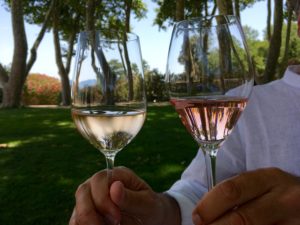
Whispering Angel, it turns out, is the estate’s entry-level wine. It is the “least pale,” as Tom puts it, “but it’s pale enough.”
The cicadas are in full chorus as our small group descends Château d’Esclans’ sun-drenched drive and ducks into the cool of the original tasting room. Stone chambers and tiled passageways lead from here to an airy tasting room dominated by an enormous stone table. Bottles of rosé, from regular to enormous in size, line the far edge of the table.
Tom switches on four trickling fountains in the corners of the room. “Let me ask it this way,” he says as we lean around the perimeter of the table. “Who hasn’t tasted Whispering Angel?”
Not a soul dares to budge, but I believe the (lack of) response. Whispering Angel is a well-known and respected rosé in the Côte d’Azur.
Tom cracks open a magnum, the darkest in the pale series, and walks around the wide table, pouring ample tastes into each glass.
Whispering Angel is aged in stainless vats, he says. It’s ideal for an apéritif.
Funny that. I always thought it worked perfectly well with fish and chicken. And pizza and pasta and even the humble pan bagnat.
Someone asks about the rosé piscine. Adding ice cubes to rosé – a practice Philippe and I regularly keep – is my other burning question. I just hadn’t gathered the nerve.
“You do see that syndrome,” Tom says, “which I don’t care for.” No surprises there. Structure, he says, determines how well wine holds up to water. Even so, the rosé gets watered down if you don’t drink it quickly enough.
“It’s a way to get water into your system,” another female guest offers. She understands. A Côte d’Azur summer can be a marathon.
I sip while many others drain their glasses. As our host uncorks the next bottle, I discover the corner fountains are actually ambient backstops to four basins. The trickling water is meant to make spitting – should anyone in this merry group be tempted – more discreet.
The tasting moves up a notch in this flight of Château d’Esclans 2016s. I’ve never seen these higher-level names, fair-weather rosé drinker that I am, but neither does Tom dare ask us who has or hasn’t tasted them.
Rock Angel, he says, is “more complex and opulent” than its Whispering cousin. It’s a hybrid wine, with some of the liquid aged in stainless and some in oak.
I sip. This glass is still light and fruity like a typical rosé, but it’s clearly superior to the first.
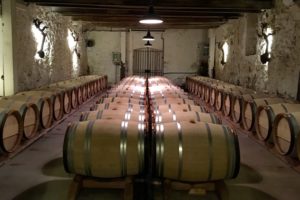
During our tour, Tom called the whole process of oaking rosé “radical.” The estate uses only new French oak, he explained. He paused before adding a mildly political tagline: “I’m the only American in this operation!”
When the third magnum begins making its round, I again dart to the corner. I hate the waste. I decide to call it survival.
“This is a wine that demands food,” Tom says as he shares out the pour. Les Clans is all oaked, and its grapes generally come from the property’s older vines. “If you taste this wine in November or December, it will evolve even more,” he says. “[Rosé] has become less seasonal.”
Rosé in the winter? It seems odd – but then I sample the contents of my glass. Les Clans is sweet and buttery. Its colour is pale peach, and its taste travels along the same rosé-white spectrum. If this is your sort of wine, then this is your bottle.
“Some [rosés] stand up to the greatest whites or reds,” Tom offers.
Philippe can’t hold back. “I’m not ready for rosé at Christmas,” he says and launches into a florid description a great red wine. He’s discussing a rare T-bone with a vegetarian.
“Maybe I’m pushing it just a little bit,” Tom admits, “but [rosés] are great with grilled meats.”
Rather than tip out my Les Clans, I take the fourth and final tasting – the estate’s Bentley, called Garrus – in a clean glass. The last two wines are crafted in a similar way, Tom says, but this one is “a more masculine wine – weightier and heavier.” Another salesperson apparently calls it “champagne without bubbles.”
I’m personally pleased to have reserved Candidate #3, but only later will I appreciate what a Hollywood problem it is choosing between these last two wines. Bloomberg recently named Whispering Angel – the mere baseline rosé from Château d’Esclan – as one of “the three wines that should always be in your fridge.” (The others, they say, are a white and a sparkling.) Toronto wine stores are struggling to keep Whispering Angel in stock this summer. In fact, a friend was holidaying in Bermuda when her local shop rang to say they’d just received a case of Whispering Angel. “Put it aside!” she insisted. “I’ll be back in a week!”
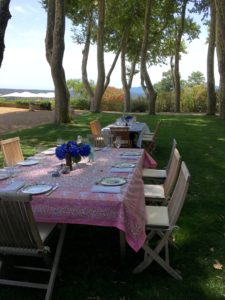
At last it’s time for our group to meet the owner. Outside the estate’s utterly fairytale château, the front lawn is set for a rosé-infused lunch beneath the abundant shade of 150-plus-year-old plane trees, towering giants having mottled trunks and the gravitas of their sycamore cousins. Blue hydrangeas from the gardens adorn a collection of pink and white tablecloths. Two gentle, golden Labradors wander among guests, silently hoping. Landscape artists must pine for scenes like this one.
“Do you know you wake up each day to utter bliss?” I say to Sacha Lichine when at last we meet.
“We’re drinking a lot,” he replies. The rotund owner of Château d’Esclans is on autopilot, milling around his front garden in another button-down pink shirt with people he doesn’t know.
Soon, though, Philippe gets him off script. The three of us walk through the lawn to the property’s overlook onto fields that stretch toward the Mediterranean. “It’s 25 minutes to Sainte-Maxime,” Sacha says, “and 45 minutes to Saint-Tropez – but only seven minutes by helicopter.”
Family, friends and colleagues continue to arrive beneath the canopy of soaring plane trees, enriching our tasting group. As I mingle, one guest says she met her companion at the Cannes Film Festival. A friend of the owner’s family explains how her family’s life stretches between France, England, the Seychelles and New Zealand.
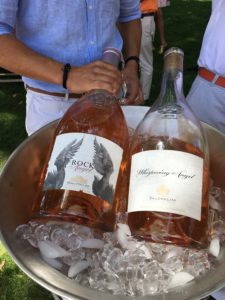
Weaving among us, a couple waiters wield enormous bottles of Whispering Angel and Rock Angel like automatic rifles. One garçon tells me each bottle is called an “impériale” and holds six litres of the pink gold. That’s equivalent to eight regular bottles. Next year, he says, the château plans to introduce a nine-litre bottle.
Apéritifs roll into lunch, as with any good Provençal afternoon. Out come Les Clans and Garrus to accompany a buffet of shrimp, fish and chicken, beets, deviled eggs and marinated cœur d’bœuf tomatoes. Sacha circulates more comfortably now. He lingers at the head of our table as we lunch, and I ask him, as a Frenchman from Bordeaux, how early he began his association with wine.
He can’t put a number on it, but he started early, he says, by learning how to spit. His father was a US wine importer. The elder Lichine set up target practice in the yard and told his young son to aim for the stone.
And the afternoon rolls merrily along from glass to glass, not an ice bucket in sight. Sacha’s effervescent sister rolls up. She’s wonderful. She invites me to bring Philippe to New York and stay with her in her apartment. I’m feeling like family. Or maybe it’s the rosé?
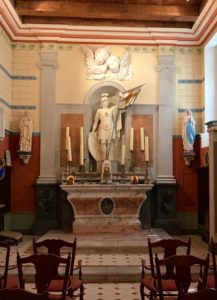
Meanwhile Sacha has taken Philippe off somewhere. My husband delights in showing off his photos on the car ride back to Antibes – as we’re buckled safely into the back seat, I hasten to add.
“He took me to see the chapel,” Philippe says. There, mounted at the back of a narrow and lofty hall, holding vigil over a marble-and-granite altar, was a pair of carved, white cherubs.
Sacha found his inspiration for the estate’s new hallmark there at the end of Château d’Esclan’s private chapel. The label had needed invigorating. Little would the sculptor of these two angels have realized his handiwork would someday reinvigorate a brand. Nor, undoubtedly, would he have foreseen the breadth and glamour of their fame.

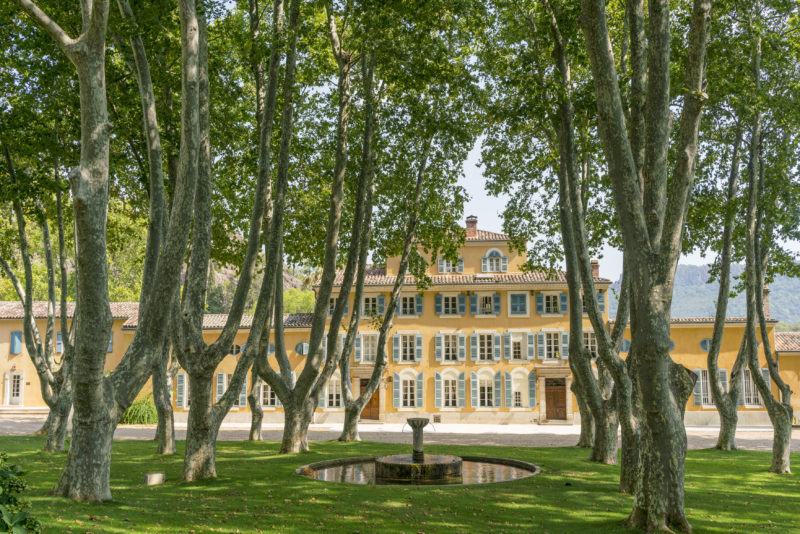
I had the pleasure of cycling around Provence last week with my fiance and we had a great time, despite the 38-40C heat and unexpectedly Basil Fawlty-like hotel management in many of the places we stayed. We did drink a lot of rosé while we were there too, but not this one: I will look out for it.
Thanks for the post and I hope you managed to survive the heat . When the wind blew one afternoon, I compared it to the opening of the Gates of Hell !!
It sounds like a wonderful day with last memories.
Laura
Love the blog. The LCBO has been out of Whisperimg Angel for 2 weeks! Enjoy- we are jealous.
I will look for these rosés though my favorites
are from the “Bandol” appellation.
Oh Jemma, you have transported me from Bellingham WA to an afternoon of delight. I’m still looking for such a rose
Just charming!
Thanks for this, a very interesting description of what sounds like a lovely afternoon.
On a hot evening I would only trade a glass of this wonderful rose for a glass of the Grand Dame champagne. Cheers, Roma
What a wonderful description of your wine tasting experience. I must try Whispering Angel. Thanks to you, I will be searching!
Whispering Angel is indeed divine!
The vins rosés have an immutable reputation for going down easily like a cold sake, refreshing and innocent as spring water until minutes later it taps you on the shoulder and Shazam! Baptism by fire. When did light and fruity pack such a punch. It will take a whole lot more marketing to extract la saisonnalité de vin rosé, but Garrus seems in a class of its own. [Could Garrus be the new pink?] Thank you French lessons for a delectably descriptive summer that very pleasantly blurs the realm of representation and reality!
I love this best: “I’m not ready for Rose at Christmas” !!!
Bringing a bottle of Laura up to the Russian River where she can be among friends